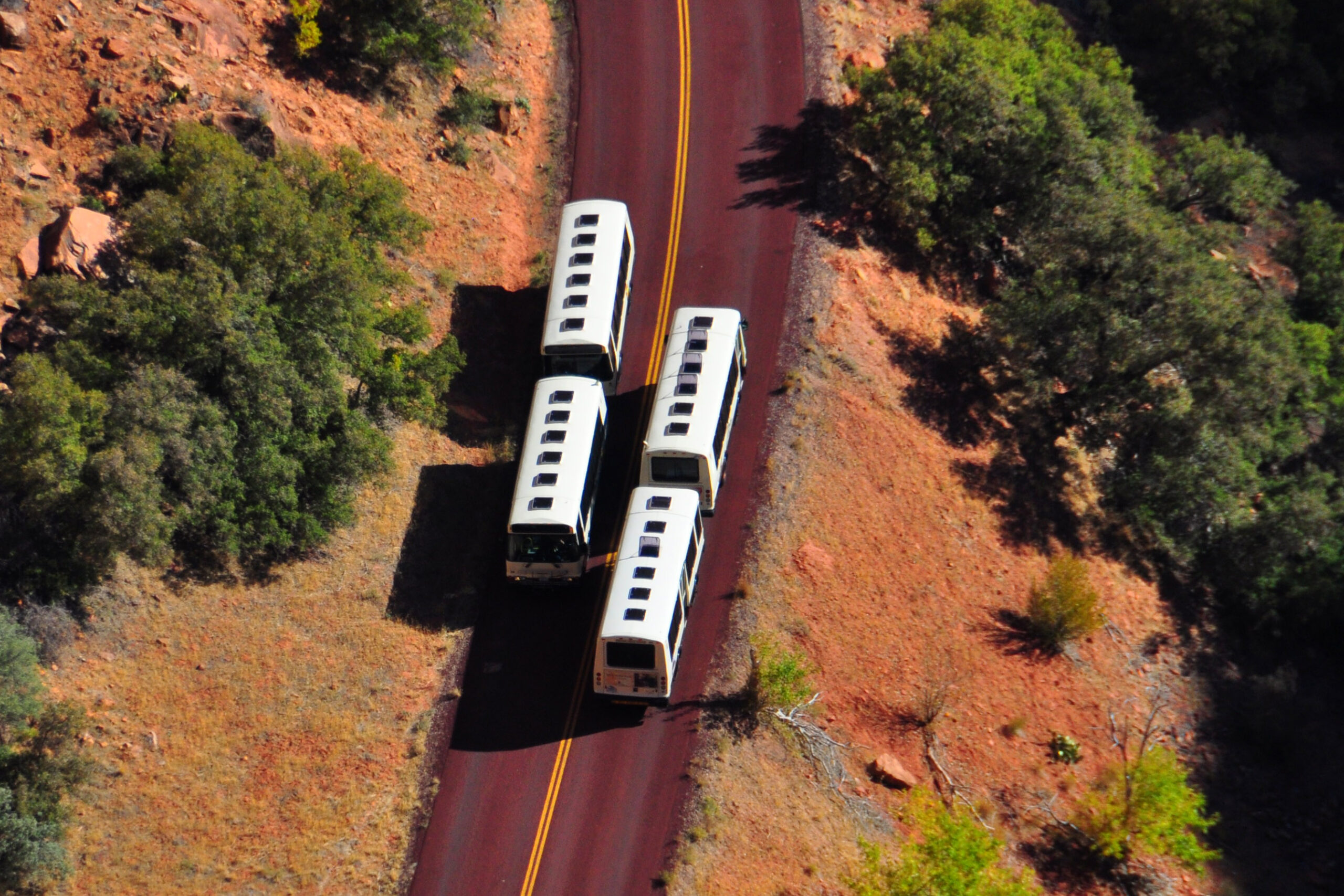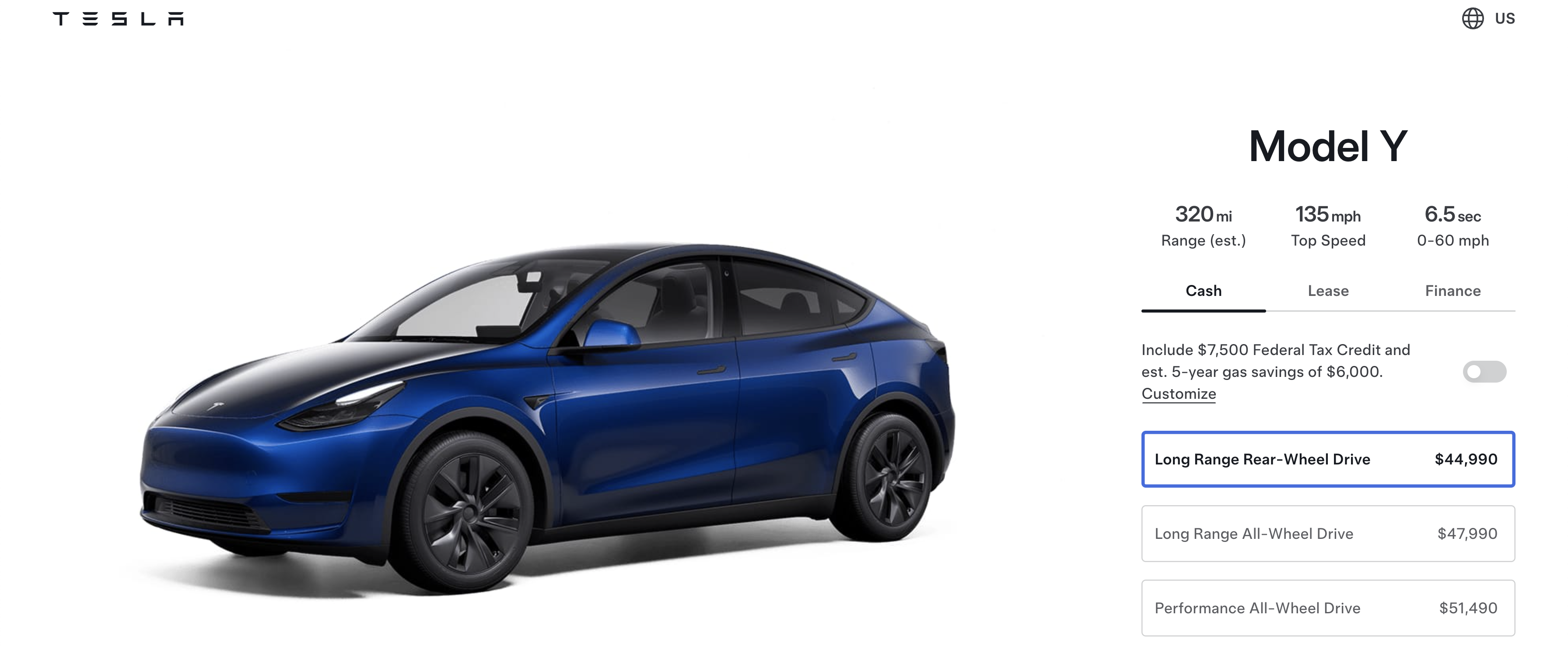Sign up for daily news updates from CleanTechnica on email. Or follow us on Google News!
Under the auspices of the India Smart Grid Forum, the think tank founded as an umbrella organization over India’s 28 state utilities to provide thought leadership, share leading practices, and bring international insights to India, I’m delivering bi-weekly webinars framed by the Short List of Climate Actions That Will Work. With the glories of online recordings and AI transcription tools, it’s relatively easy to share both the transcript, and also the slides that I used, so I’m making a habit of it.
Most recently, I delivered a talk and held a Q&A session covering my thoughts on a very aggressive grid expansion and optimization for India, focusing on technologies like HVDC, smart dynamic line rating solutions like Heimdahl’s magic ball, and modern composite conductors. For those who prefer talk-talk to read-read, here’s the recorded video of the presentation and discussion.
Reji Kumar Pillai: Good morning, good afternoon, good evening to all the participants from around the globe. Thank you very much for this third edition of this webinar series on climate action that will work. As I said in the introduction of the previous two sessions, at the cost of repeating myself, I would like to reiterate that most of the studies say 2 billion machines that are today running on heat or fossil fuel will get converted into electricity. So electrification of these 2 billion machines around the globe in the next three to four decades would require tripling of our electricity capacity and all the new generation resources which are going to be mostly solar and wind and how do we make them from millions of kilometers, thousands of kilometers away from the loads and the solar farms and the wind farms, what electrons are produced, we have to make it available to the load centers, to the electric vehicles, to the factories, to the offices to the industry, so many places we need to build new grid.
As I said in the previous webinars, the BNEF estimate of November 2023 is that we have to build about 80 million transmission and distribution lines at an estimated cost of $21 trillion in the next 25 years, which is a very tall target and at the same time huge business opportunity.
I would like to take a minute to talk about what India has done. For solar and wind we have about 135 and 237 gigawatts. Wind was built in the last two decades, but most of the solar was built in the last one decade. We have been very successful in moving power generated from the large solar farms and wind farms which are in the northern, western, and southern parts of the country to any part of India.
We have more than 100 gigawatts of inter regional power transfer capacity. That’s a transmission planning which India has done. We operate 800 kV HVDC lines, 500 kV HVDC lines, and 765 kV and 400 kV AC lines which are the backbone of the India grid, which covers 3 million km², connecting over 300 million customers and operating in one frequency with a total installed capacity close to 430 gigawatts.
What we have done at the time, when we looked at a big ambitious plan for renewable energy development that was some ten years ago, we looked at for movement of power from large solar farms and wind farms, which are more concentrated towards the west and north and southern part of the country, some eight to ten states. We have to build high capacity transmission corridors, so we call them green corridors. The first phase of green corridors we completed, the second phase we are doing. And these green corridors are not the regular transmission lines because we have the government of India providing viability gap funding. Many of these lines may not be running at full capacity 24/7 because solar generation and wind generation, the capacity utilization factor is in the range of below 20%.
Power Grid Corporation of India is a government-owned company, majority-owned by government, it’s otherwise on the stock market. Power Grid Corporation of India planned and built these green corridors, mostly 400 kV some places to 20 kV transmission lines and substations, bringing them connecting the wind farms and solar farms to the main polling stations for which government of India has given viability of funding. This was a major step, a visionary step taken by India so we don’t have much of curtailment, in fact almost zero curtailment of power from wind farms and solar farms.
Another thing which we have done is we also set up renewable energy management centers (REMC). They are equipped with sophisticated tools for weather forecasting and they are helping our system operators to forecast generation from solar and wind more accurately. Typically what they do a day, minus two. Today, what we estimate is for Saturday, what is the generation from each of the solar and wind facilities on Saturday we estimate today to give it to the power system operators. And tomorrow, with better data, weather data we fine-tune it. During the day on Saturday, we will do intraday mitigation measures.
As I said, 3 million km² is operating as one grid. The larger the control area, the better it is for addressing the changes in the generation pattern according to the changing weather. This is something which we have done much better than many of the developed countries and power system planners and operators are most welcome to use as an example.
Without taking much of your time, I will hand over to Michael, who will take you through today’s session where he’ll be talking about HVDC. India started with HVDC way back in 1989 — the first HVDC bipolar and back to back station was commissioned in those days about 30 years before.
ISGF has been talking of late about the SCADA systems, which you have, it measures only the electrical parameters. That is not enough with the changing weather pattern. We need to measure the physical dimensions. And the atmospheric conditions as well need to come into our SCADA systems. After Michael’s presentation, I will request one of our advisors and working group chair, Mister Ravi Siddhabad. He’s also incidentally based out of Toronto in Canada. He’s on the call. I will request him to talk for about five minutes about what we are talking about. The new generation of SCADA, where physical parameters and weather parameters will be added in addition to the electrical parameters. That’s where the latest work is going on. And something about the smart balls. Michael is also going to talk about it, how we in real-time monitor the temperature of the wires and then accordingly load that.
Over to you, Michael, for an interesting session.
Michael Barnard: Thank you, Reji, as always, thank you to you and the ISGF for allowing me to share what I can to assist India in this marvelous journey.

Getting right back to the basics, as we consider electrification, right now there are many places where we have a bottle of gas sitting beside a house and that’s providing cooking heat and hot water. We are not going to have that in the future. We’re going to have heat pumps that require electricity. We have to think about the grid as an incredibly fractal thing. We think about this massive transmission network, some of the stuff that Reji was talking about with the green corridors, and then we get down to the highest voltage distribution lines, then we get down to the local lines, then we get down to the lines and buildings. It spreads out like the roots of a tree.
It requires the same heartbeat, it requires the same frequency, it requires reliability, it requires the same voltage. When people plug something into the wall plug, it just needs to work. That’s not trivial to do, but it’s provably easy to do with renewables. If we take Denmark and Germany especially, because it’s a more highly populated, more industrialized country, they’re over 60% of electricity from renewables these days, and they have a grid reliability of 13 minutes of outages per customer per year on average. That’s kind of a level set. If we look at North America, it’s averaging about 2 hours of outages per customer per year. We look at Kenya, it’s much worse.
But it’s all entirely possible. There’s nothing about renewables that prevents this. The stuff that Reji was talking about, the two-day-ahead weather forecasting across broad geographical regions to enable grid planning decisions and merit order, stuff that requires transmission. I’m going to be talking about the top layer of this, the transmission layer, today.
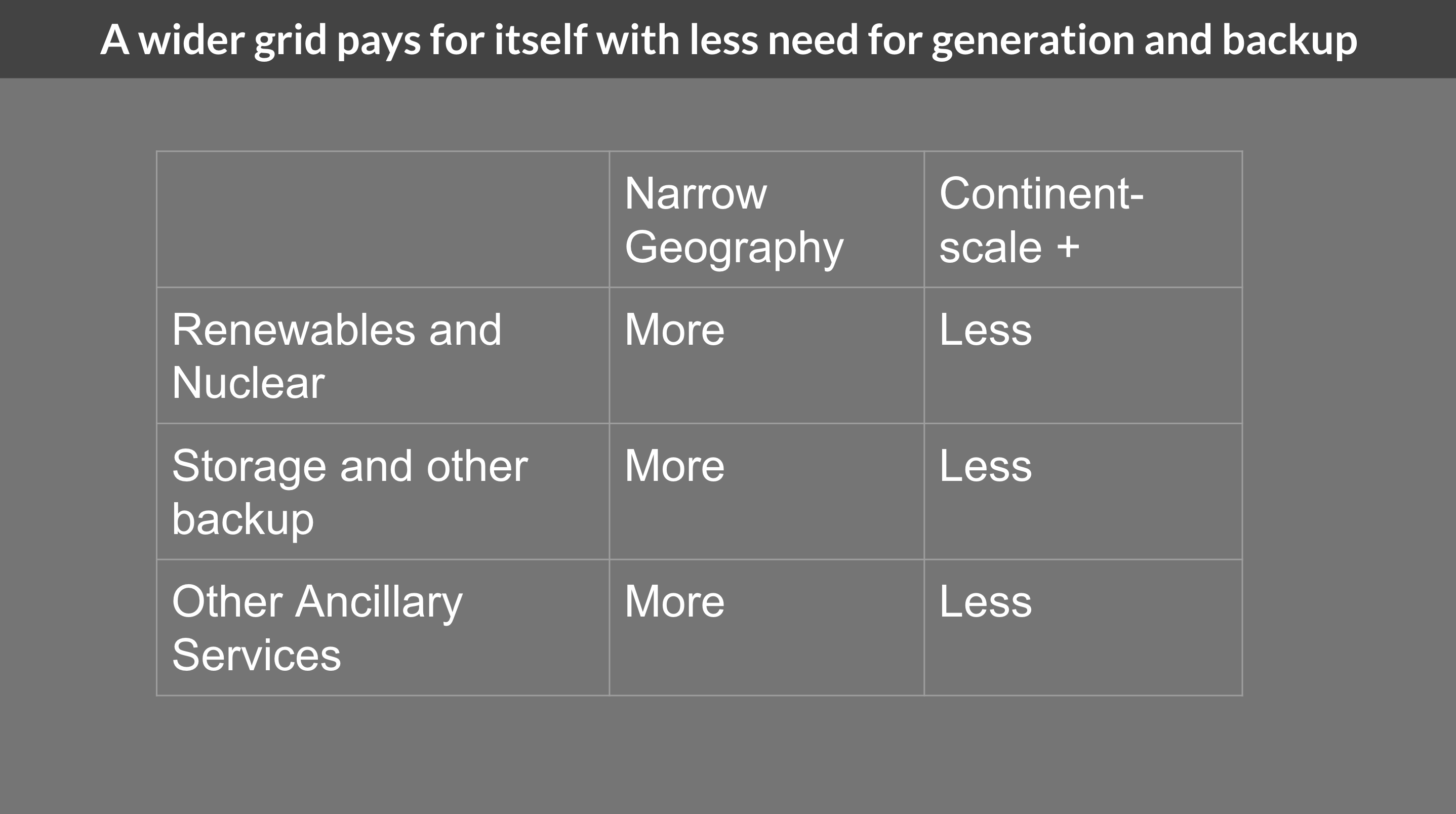
There are some really basic value propositions about broad grids. If you have a narrow, constrained geography like one of your states, and you only did grid planning in there, and you only did renewables in there, well, you’d need more renewables and other forms of low carbon generation in order to balance out a greater percentage of those per capita. Similarly, for storage and other backup, you need more backup and storage if you’re geographically constrained. Similarly, other ancillary services of frequency and voltage management.
But as you get to that concept of continent-scale grids, like all of India and India plus, then you balance these things out. You find an optimization where you are trading off transmission for generation, for storage, and for ancillary service management. You can find that optimization.
I’ll talk about a study out of Africa that talks about that, and it’s similar to the studies that India has done, but it means that we have to look at some of the older studies, especially. A lot of them were constrained to small geographies like a US state, and said, well, obviously renewables won’t work because they’ll be very expensive because they intentionally constrained the geography. We have to think bigger with renewables, as Reji points out.
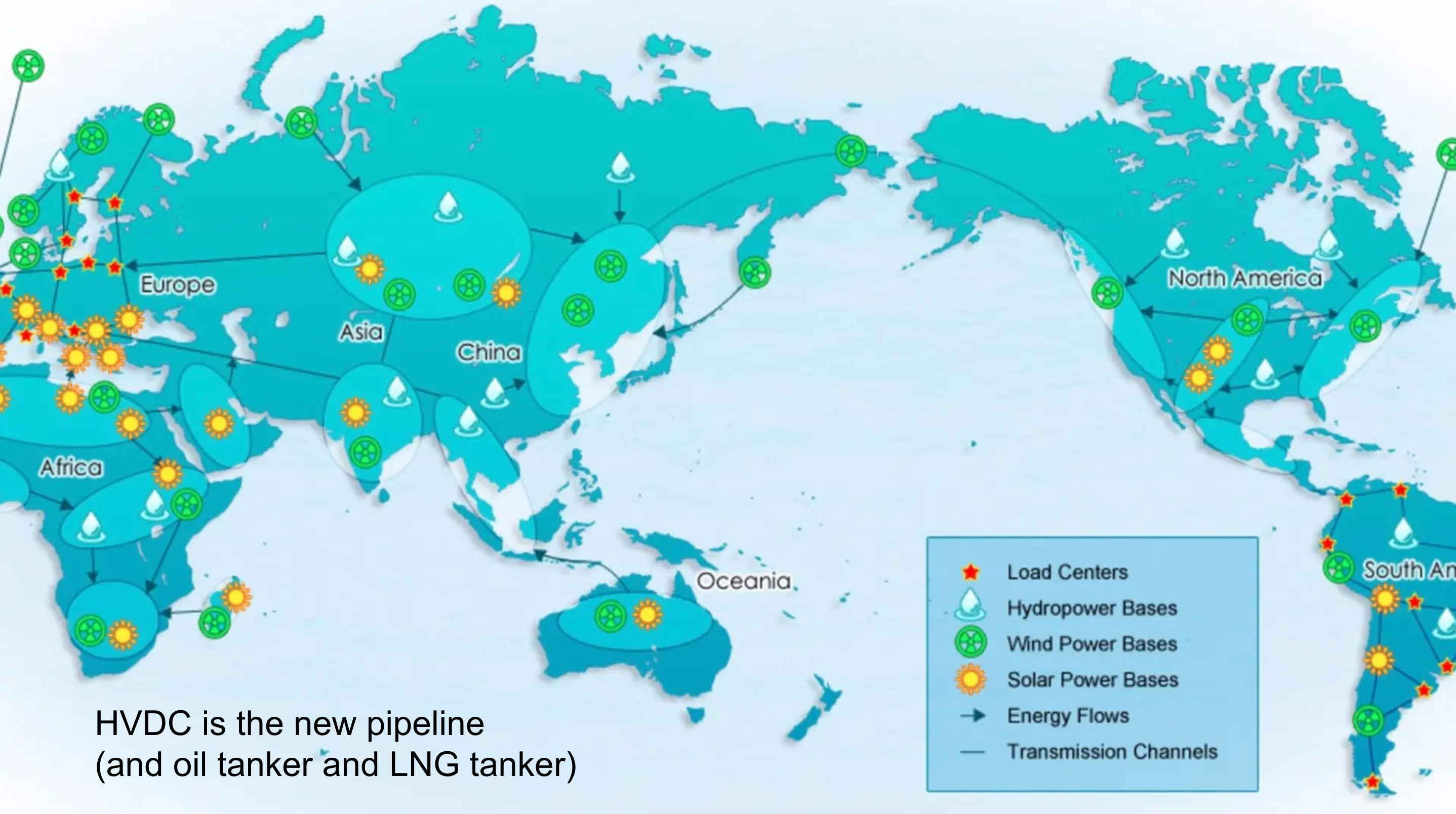
This diagram is from the global energy interconnection and development and cooperation organization, GEIDCO. It’s a China-led, China-created organization with 141 member states, which overlap significantly with the Belt and Road Initiative member states. The ISGF is a member organization in GEIDCO, as are hundreds of other organizations that focus on electricity in grids globally. What they propose is truly a global grid.
You can see India has solar power, wind power, and hydropower bases, and it’s connected to the rest of Asia, east and west conceptually. This is the way we need to start thinking about it. Oceania down here in Australia starts being connected into Indonesia. Right now there is a HVDC project called Sun Cable that is expecting to bring electricity into Singapore here, where I lived for a couple of years, simply because Singapore is the richest of the ASEAN nations by far. It’s a tiny nation, but it’s incredibly wealthy.
As we look at this, you know, what we start seeing is, oh, well, when India is looking at its wind and solar capacity, as in its two days ahead, in the future it’ll start being able to have conversations with eastern Africa and Central Asia and the ASEAN nations to start finding ways to supplement, to share excess electricity during the day and to supplement peak demand periods from further abroad.
I like to say that HVDC is the new pipeline. I also say it’s the new oil tanker and the LNG tanker. As one of the data points on that, last year we had about 911 very large crude carriers — the biggest oil tankers — in operation, and they last only about 25 to 30 years. In any given year, you’d expect 25 or 30 of them to be on order, but only one was on order. The maritime shipping industry knows that oil and gas is going away. 40% of the bulk shipping is of fossil fuels.
We’re going to be displacing a lot of that with high voltage direct current transmission, but not nearly as much energy for the simple reason that we can generate a lot more electricity locally. Countries that are poor in fossil fuel resources still have the sun and wind, and so they can generate a lot more locally.
Secondarily, the point of electrify everything everywhere all at once is that an electric pathway from renewables to electric energy services is vastly more efficient than fossil fuels to any services. It’s three to six times more efficient to use electricity directly to do something than to use fossil fuels. We don’t need as much energy to deliver the same economic and comfort value. We can generate a lot more of it locally, but we still have to share some across borders. HVDC is the mechanism by which that occurs more than not.

For context on HVDC, India has, as you can see, a tremendous number of projects, but it’s a global thing. HVDC is literally everywhere. High voltage direct current was originally created by ABB in Sweden. The 75th anniversary of the first installation was last year, I think, to give you a sense of how old that was.
A lot of it was built on the old LCC stuff where it was just big massive plates that were converting between two AC services. They’re back to back conversions. One of the first 1st uses of HVDC was to say, okay, we’ve got a grid region here with one frequency and a grid region here with another frequency. Let’s put some HVDC here to have an asynchronous transmission of power between two synchronous grids, so that we can avoid having to match frequency. That’s a very useful purpose. As we look at Japan over here, a lot of Japan’s HVDC is back to back.
But now we have VSC, which basically digitizes the signal matching. It’s a very efficient mechanism that is much more efficient at moving between grids and moving between frequencies. That’s one of the key advantages of high voltage direct current, is it doesn’t care what the frequency is on either end. The transformer stations match the frequency at either end.
We’re starting to see tremendous efficiencies, another advantage of HVDC. One of the biggest transmission lines in China is seeing 1.5% losses over 1000 km. This is a tremendous efficiency for transmission. It’s viable because just like high voltage alternating current, the more juice you put through a wire, the better it is in terms of its efficiency, all else being equal. They’re proving what can be done. They have 12-gigawatt connectors coming in from the Three Gorges dam into the demand centers over here. There’s a tremendous amount of potential with this technology.
As you can see, to Reji’s point, India has more high voltage direct current than all of the United States, a full 50% more. India has done a much better job than North America and mostly Europe as well, such as the green corridor transmission. The number of stories out of the developed world about interconnect queues that are a decade long for new renewables projects is indicative that the western world lost track, that the grid is absolutely essential to this transition. Good on India for not losing track of that.
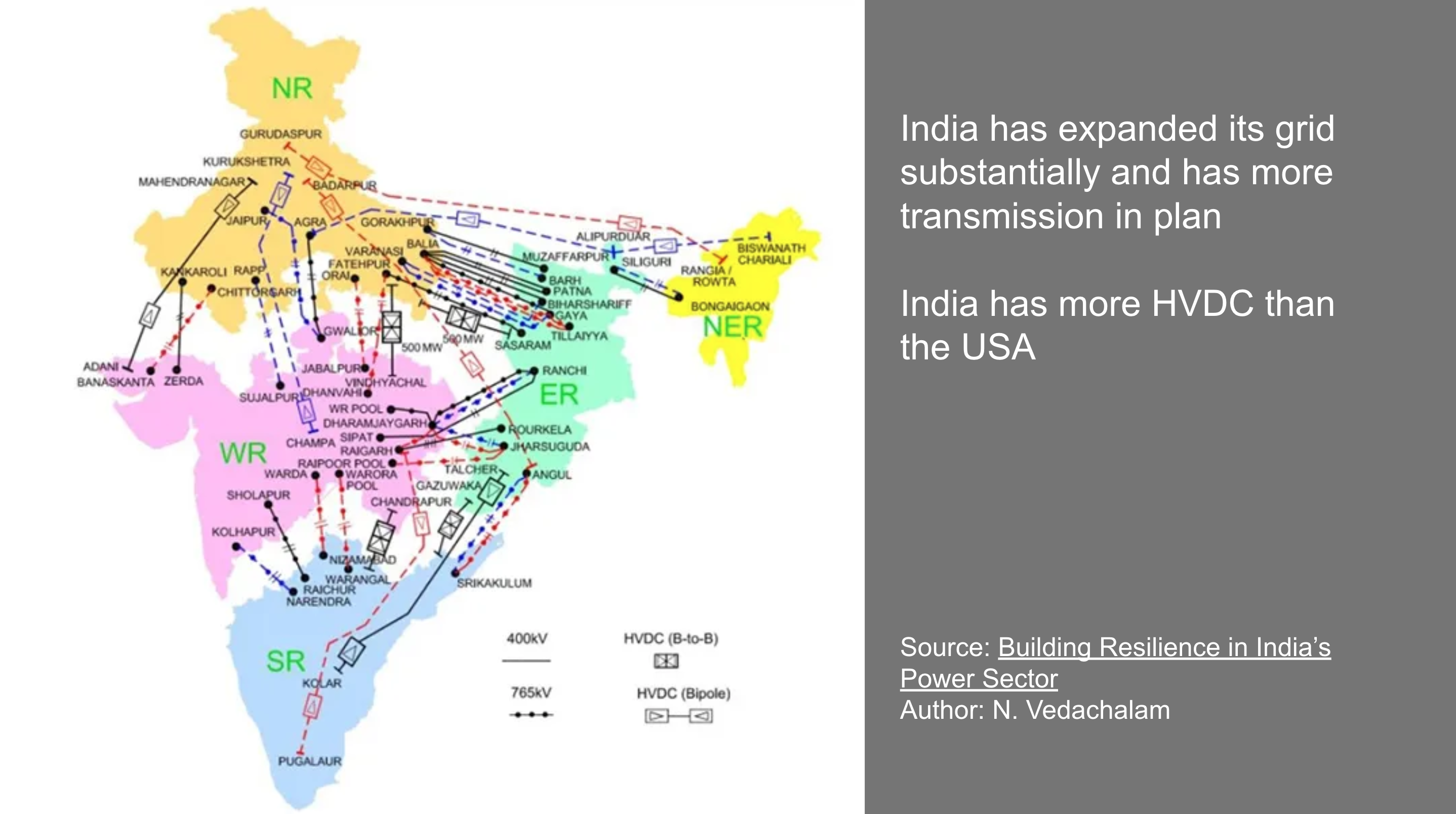
Reji talked about India’s efforts with the full national grid. We have the basic regions. Lots of interconnect work has been done. We’re now starting to see 1,200 kilovolt and 2 gigawatts as fairly standard for interconnectors. For HVDC, we’re starting to see it really ramping up in terms of scale. When I talked to the head of HVDC for DNV, the global firm which does standards for HVDC as for all of energy systems, for shipping, for pipelines, and for transmission, he says 2 gigawatts is the standard now. We’re starting to see bigger and bigger because HVDC is not limited in the same way that HVAC transmission is — high voltage alternating current. Because of the way the alternating current works, little eddies show up in the transmission, and they mean that more and more, it’s only the skin of the line that has electricity flowing through it. With HVDC, it doesn’t have those effects, so the entirety of the conductor’s three dimensional space is actually conducting electricity. Tremendously useful in that regard.
Further, HVDC generates a lot lower magnetic fields and so interacts with its surroundings a lot less. That is part of why it has much lower resistance than HVAC, especially underwater or underground. One of the reasons that offshore wind farms are all connected with HVDC is because you don’t lose nearly as much to resistance because the magnetic field is interacting with the water the cable is passing through.
India is doing a good job. It can do more, and it will need to do more because, as Reji said, there’s a lot more power that has to go through these things. India is ahead of the game in terms of starting that expansion. This is another place where India is leapfrogging the west, but it still has a lot more to do.

I put this together just to give a bit of an idea of some of the constraints. I looked at the depths of the Arabian Sea and the Bay of Bengal to see if it was possible to connect easily to Malaysia and to Indonesia. And it’s not. The Bay of Bengal and the Arabian Sea are very deep bodies of water. Tight now we are putting HVDC subsea cables down to quite significant depths, as low as a couple of kilometers. But the Bay of Bengal and the Arabian Sea are very deep bodies of water, as you probably know.
The point here is that there’s an opportunity for bigger, broader backbones to get further across India and to get into the ASEAN region and Africa. This becomes viable because while India is a big country, I think 7th largest square kilometers in the world, it’s not a wide country, it’s longer. It’s longer top to bottom than east to west. What that means is that eastern sunshine is not that different in terms of time of energy than western sunshine. You can’t move electricity from sunshine as easily as the United States can, as China can or as Canada can, because they’re broader countries. We have five and a half time zones in Canada, for example, in our absurdly broad country. We also have all of our population within 160 kilometers of the border because the rest of the country is very cold and full of biting insects and large bears. It’s mostly inhospitable and empty.
What I suggest is get over here into Oman, then you get into the African grid and that’s a viable depth for transmission. Get over here into Myanmar, you’ve already got interconnectors into Bangladesh and Nepal, you’ll be growing those. Grow big connectors east and west at the top, get down to Sri Lanka and then you can start sharing the resources more globally.
As the previous slide showed, you have connectors between the grid regions, but you don’t have a big one going all the way from top to bottom or east to west right now. I’m suggesting that’s something to think about when we talk about grid in the future. In the future, electrifying everything, we really have to think big.
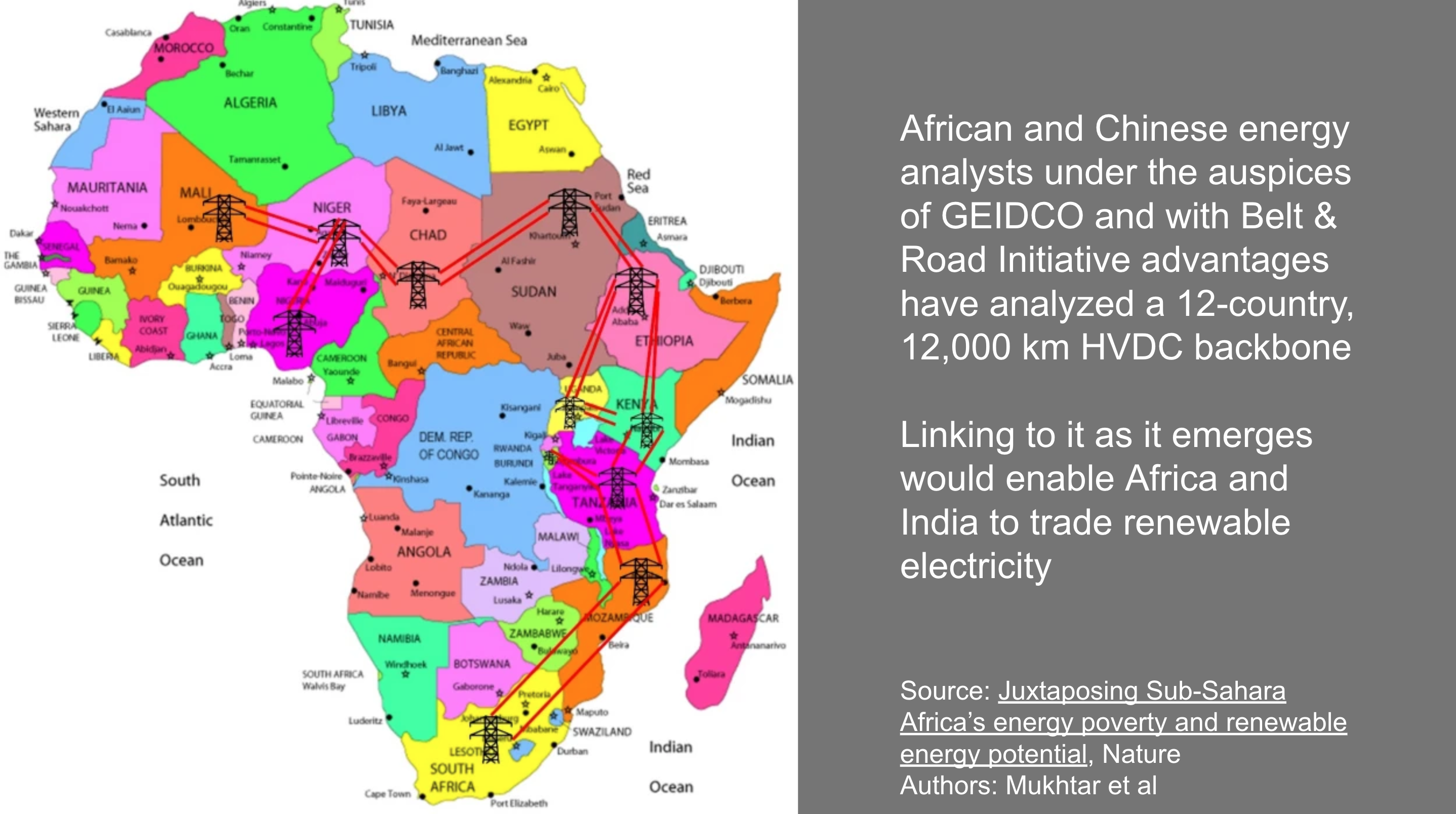
Here’s an example of thinking big and something that is an opportunity. A couple of years ago, a group of Chinese and African energies researchers published a study which looked at putting a big HVDC backbone 12,000 km across twelve countries from sub-Saharan western Africa across into Ethiopia and fairly affluent Kenya, then down that coast into affluent South Africa. They modeled out a mix of generation capacity, both legacy fossil, but also renewables and other stuff, and grid storage that they would put across this interconnector and have it flow north and south as generation opportunities occurred, east and west as solar opportunities occurred. What they found is that mixed grid, a mixed set of generation across those grids was quite reasonable economically.
But there’s a problem, and I’m not sure India solved this problem, so I hope somebody will share this with me. They’re using European-developed software. This is an African-Chinese initiative under GEIDCO and with Belt and Road eyes on it, which gives it some likelihood of potentially happening, but they had to force the software to do unnatural acts, because most of this grid management software and grid planning software for analysis of these types is really constrained to a country, or one of those regional grids.
It also had limits in terms of the types of storage. It had limits in terms of the types of generation that you could put on, the number of units of generation. It’s like Simcity. If anybody ever played Simcity, I just found it distressingly simplistic in terms of the options for electricity and stuff like that.
Even the most sophisticated software struggles with this breadth of terrain and grid solutions. It’s certainly not a computational resources problem, but it does require working hard to figure out what that really broad vision is and how you’re going to interconnect into it.
My assertion is that 45 of 46 sub-Saharan countries in Africa, that’s 45 of 55 total countries in Africa, are members of the Belt and Road Initiative. China is the global leader in HVDC. India is doing an amazing job, but as always, in these cases, when we look at China, it’s mind-boggling how much they built. They have their own HVDC technologies. They have their own HVDC cable plants. They have their own VSC technologies.
Every major player like Hitachi, which bought the HVDC portion of ABB a few years ago, has manufacturing facilities in China, as well as in the United States, as well as in Mexico and Europe, so it can avoid some concerns about Chinese technologies.
The point there is that China’s technology is probably going to be dominating in sub-Saharan Africa, because that’s part of the Belt and Road. New customers for Chinese technologies and locking in resource value propositions, especially for the resources of the future. There’s a reason that China has a lock on about 80% of processing of all battery minerals, because the Belt and Road Initiative went in and developed the countries that had those battery minerals, so they could extract them, share the benefits with the local region, and move on.
This then becomes a key pathway for sub-Saharan Africa becoming affluent and also becoming a region for India to connect with, to share electricity across broader east west pieces. Ethiopian sunshine could be powering New Delhi’s nightlife, and similarly, nighttime electricity in India in 15 years could be powering Kenya. There’s a really interesting opportunity to start thinking more broadly.
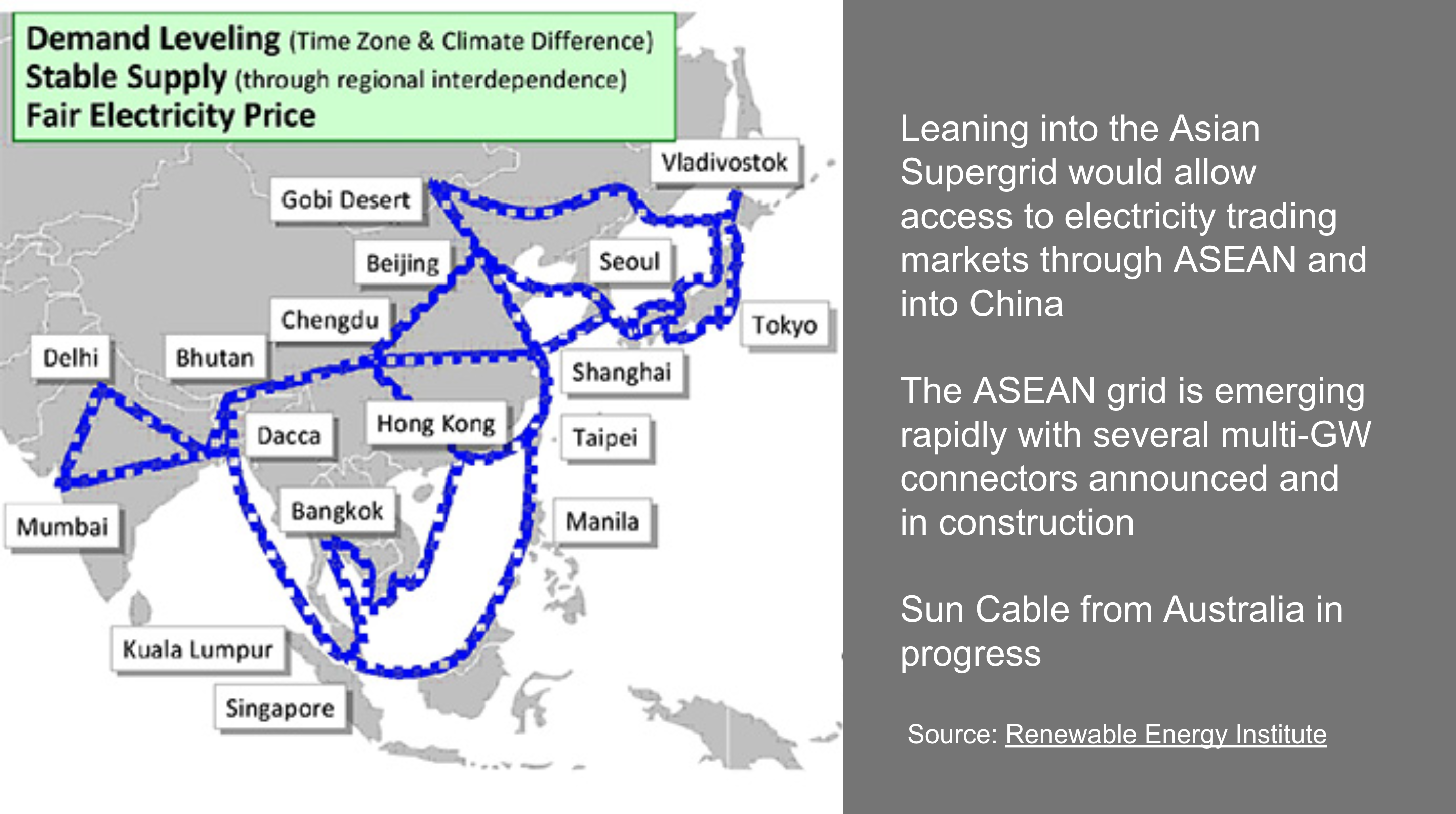
This is an older chart from the supergrid organization. Once again, it’s talking about how we connect Delhi, Mumbai and Bhutan, the Gobi desert wind farms, the major demand centers of Beijing and Shanghai, and down into Indonesia, the Philippines. These are all very accessible solutions.
When I assess Japan, it’s fascinating to see how resistant they are to doing the really obvious thing, because they have very shallow, accessible waters to South Korea, mainland China, and into Russia right now. Vladivostok is a long way from Moscow, so it’s less likely to be a bad actor in that regard.
All energy imports and exports are already at risk of global disruption. We saw that with the energy crisis in Europe a couple of years ago after Russia invaded Ukraine. Hedging is done for all energy imports now, when we start interconnecting with other countries, no matter how fractious the relationship frequently is. I believe that there’s some fractious relationships between India and neighboring countries that India has been managing since 1947. Those fractious relationships don’t mean you don’t trade with them. It does mean that when you look at an interconnector for electricity, which is benefiting both, enabling more communication with both, providing economic value for both, you do want to hedge for potential for that connector to be turned off or turned down, just as Nord Stream one and two were turned down by Russia early in the war and then somebody blew them up. I still think it’s Russia, but all the investigations have been able to determine is that it was most likely a state actor, but not which state.
Hedging for disruption of your energy services is something we do now and something we’ll continue to do in the future.

We already have a lot of transmission of all types globally. India’s built a lot. It has a lot of high voltage alternating current, and it has a lot of HVDC, and they have operating parameters. Here’s a really interesting thing that’s occurring now. Historically, transmission lines have been a core of steel strands because steel is strong, surrounded by strands of aluminum, because aluminum conducts electricity really well and is light. The combination means it doesn’t sag too much and it transmits electricity.
But there are a couple of problems with that. One is that both steel and aluminum sag more when they get hotter, and further, the aluminum is unannealed in legacy transmission. As it gets hotter, it anneals, and its efficiency starts to change. The operating parameters start to change.
What we have in advanced conductors is a core of composite materials, carbon fiber, which is incredibly strong, doesn’t sag, and is very light. It’s lighter and stronger than steel. You don’t need it to transmit electricity. We need it for the flexibility, lack of sag, and we want it for lightness. Aluminum is used instead of copper in transmission lines because aluminum is lighter than copper. It really matters when we’re putting up pylons and spanning wires across hundreds of meters, that the wires be as light as possible. Secondarily, we change the way that we construct the wires with trapezoidal strands of fully annealed aluminum. What that means is, if they get hot, they don’t change the way they operate.
We’re starting to see multiple vendors now delivering this. What does that mean? It means if we have existing pylons and lower generation in places that are heat impacted, especially, or places where there’s wildfire concerns, well, we can replace the existing line with a higher capacity advanced conductor, and we can get twice the electrical generation through the same transmission corridor across the same pylons.
Further, those conductors will be less subject to sag and less subject to heat extremes, causing degradation of performance. Reconductoring existing lines is this fascinating thing where we start to see significant, rapid improvement. We already have the pylons. We’re just replacing the lines with lines of equal weight but greater capacity. The engineering enables us to boost those things, so all the high voltage alternating current lines that India already has could become twice the capacity, potentially even three times.
For new lines, there’s another opportunity. New lines pylons can be further apart because once again, it’s lighter and doesn’t sag as much. So if you put pylons further apart, this more expensive conductor, combined with fewer pylons, can be cheaper overall for new high voltage alternating current transmission lines. The combination means we’re starting to see replacement of existing alternating current, and we’re going to be able to get a tremendous percentage of our new electricity transmission needs just by putting new wires on old pylons. Tremendous opportunity there, and I’ll talk about why that’s really fascinating as well, a little bit in terms of risk.
So, once again, replace conductors on existing wires with better ones, which are more fire and heat resistant. So as their temperature extremes increase, as more fires increase, advanced conductors reduce the risk associated with those.
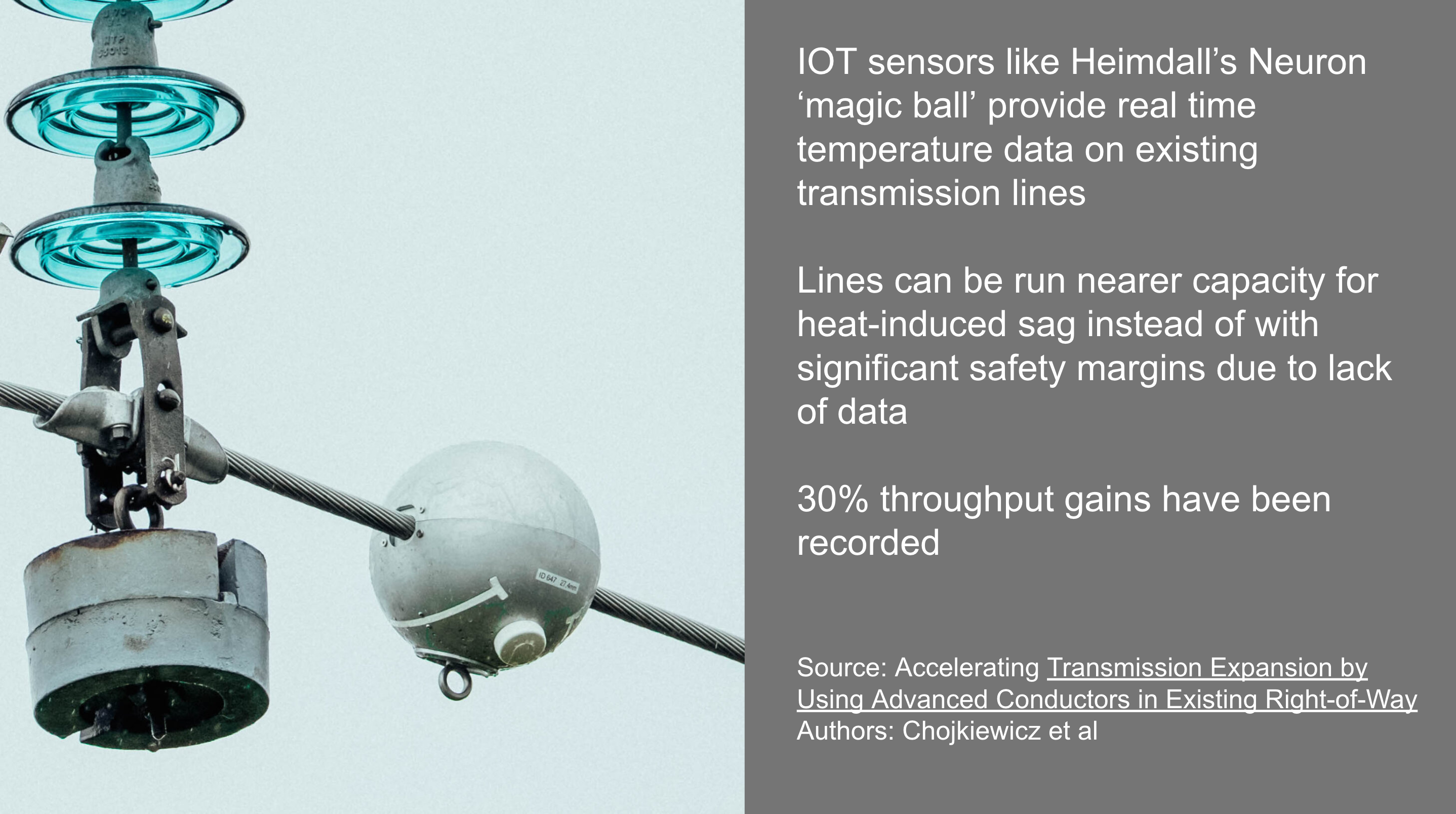
As Reji said, we have to know more closely what’s happening with those real lines. This one happens to be from Heimdall. There are a lot of smarter grid components. This is what they call the magic ball. They actually call it a Neuron, like the brain neuron, and it can be deployed by drone. An operator on the ground has a heavy lift drone, flies it up, drops the magic ball on the wire and it clamps on. It takes electricity from the wire through inductance charging, tiny fractions, just electronics and sensors, and there is a heat sensor in there. What it can do is say the line is this temperature right now, and then it has a mesh network which enables it to send data back to the control centers that are managing the transmission lines, and in some cases, the higher voltage distribution lines as well.
That tells the operators exactly what the temperature is, which means they can actually run near the engineering limits, as opposed to the rule of thumb conservative limits. They’ve actually seen, just by putting these in place with some customers, up to 30% throughput gains on existing lines. Just by putting this in place and getting the data back to the control centers, they can actually put more through. In one case, they had twin lines. They decommissioned one line entirely because it was unnecessary, because the throughput of the single line with more efficient management enabled them to achieve that.
A recent study out of the United States found that 85% of all new electrical transmission requirements could be met by reconductoring and sensors like Heimdall’s Neuron magic ball. Where there are robust grids today, they may not be in the right places in all cases, but in a lot of cases, just by making them bigger with reconductoring and managing them more effectively with more sensors on the transmission wires, and getting that data in real time can actually enable them to achieve the end result without building tremendous number of new pylons, because new pylons are frequently problematic.
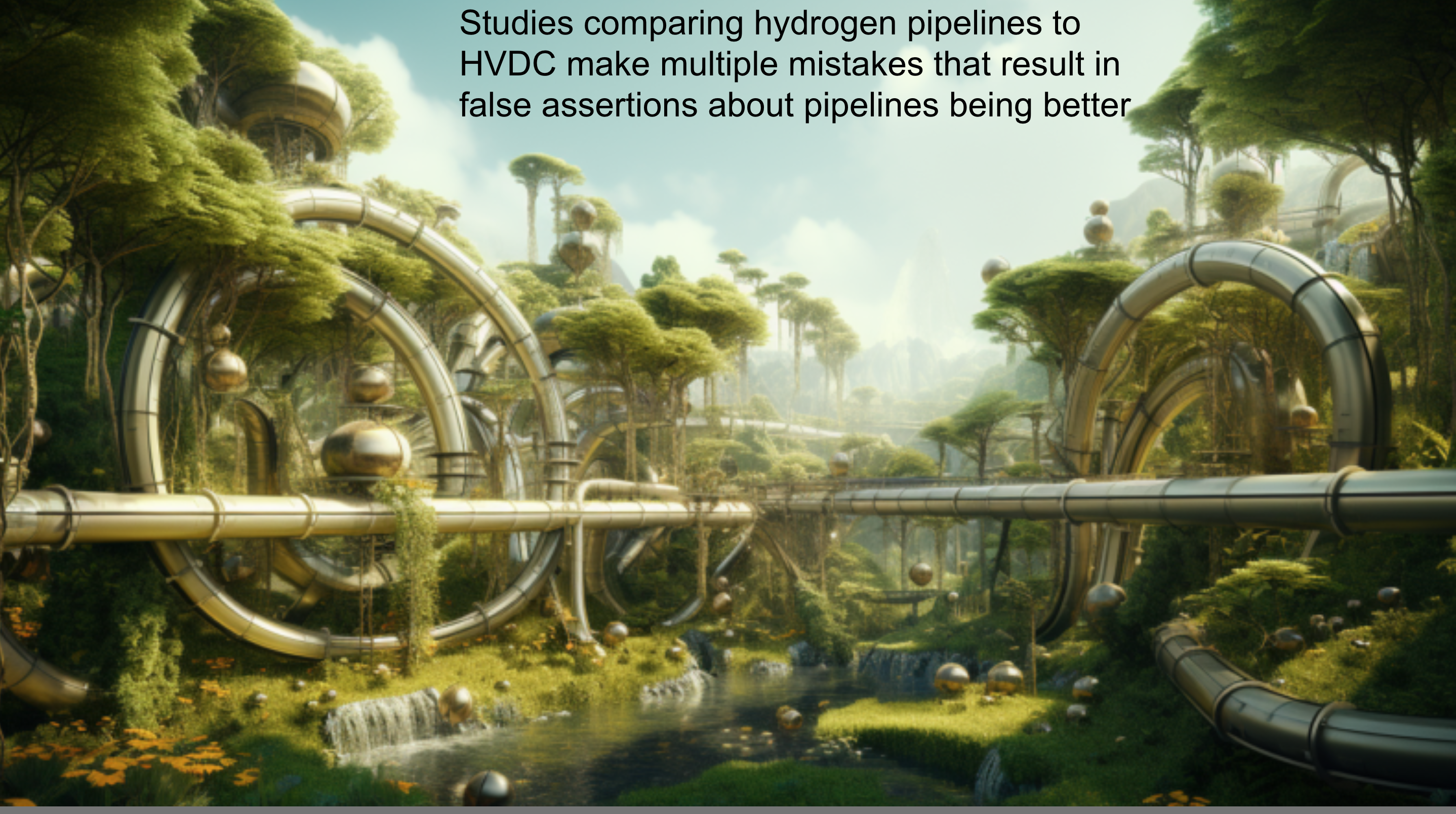
I want to keep touching on hydrogen. There are a lot of studies that are being done now saying that hydrogen pipelines will carry a lot more energy than high voltage direct current. And they keep making a bunch of the same mistakes. They mistake exergy and energy. Electricity can do work. Hydrogen can produce heat. Heat is not the same as work. Heat is valuable where you need heat. But when you need electricity and you’ve got heat, you lose 70% of the energy heat just because that’s how thermal generation works. Electricity has high exergy, the ability to do work. Heat has low exergy.
Similarly, heat pumps are vastly more efficient than hydrogen or natural gas heaters, three times as efficient, and you have to put a lot more electricity into that. They also make a mistake saying, well, the pipeline goes from A to B. Right now we have pipelines from A to B, transmission pipelines, because we have natural gas fields with massive amounts of natural gas here. We have a massive demand center there. In the future, creating green hydrogen requires lots and lots and lots of broad geographical renewables assets. Why would we build transmission into the end of this hydrogen pipeline as opposed to where the energy is actually needed in more of a mesh grid type of perspective.
I’ve published on this a few times. You can look up my articles on CleanTechnica to find why the studies which assert hydrogen pipelines are better are flawed in multiple ways. They’re starting to get better, but there’s some German groupthink which is preventing some rational thought and good analysis coming out of Europe.
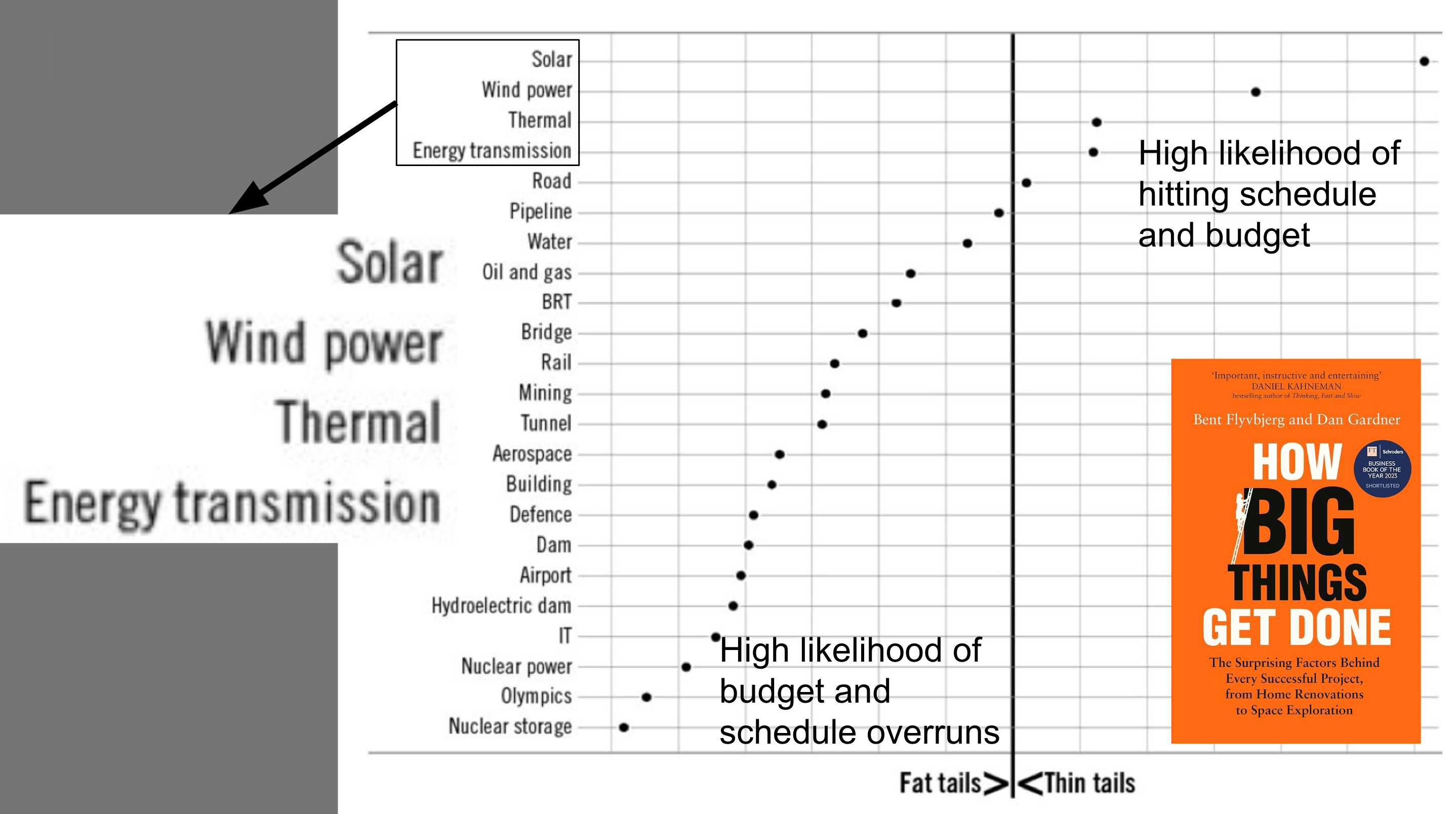
A little over two years ago, Bent Flyvbjerg and Dan Gardner reached out to me and said, hey, Mike, we’re publishing a book based on Bent Flyvbjerg’s work over the past 25 years. Your material on the natural experience of nuclear versus renewables in China is amazing. We’d like to include it in our chapter nine. I said, well, sure, okay. I didn’t actually know who Bent Flyvbjerg was when they reached out, but I looked him up and I found out that he’s a global megaprojects expert. He and his team out of Europe have been assembling data sets, high quality data sets on megaprojects, billion dollar plus projects for over 25 years. They have over 16,000 projects in their data set now.
They captured the initial budget, the initial schedule, and the projected benefits, and they captured the end cost, the end schedule, and the actual benefits across all 16,000 of those projects. They excluded any projects where they couldn’t get high quality data. They grouped them into 25 categories. This chart is sorted from most likely to hit schedule and budget once construction starts to least likely to hit schedule and budget.
I did a little call-out here. Solar, wind, and energy transmission are three of the top four categories of projects that are most likely to hit schedule and budget and to deliver benefits. Flyvbjerg has what he calls the iron law of megaprojects, which is that only 0.5% of megaprojects achieve schedule, budget, and benefits. Well, a lot more of them are solar, wind, and energy transmission than any of the rest. As China or India thinks about nuclear power, it is third from the bottom, and nuclear storage is at the very bottom.
As we think about no regret options, building transmission between wind and solar assets and wind and solar regions is the lowest risk process going forward. Reduction of long-tailed risks and speed to deliver is fundamental to us achieving affluence, achieving electrification, the benefits of electrification, and achieving climate goals.
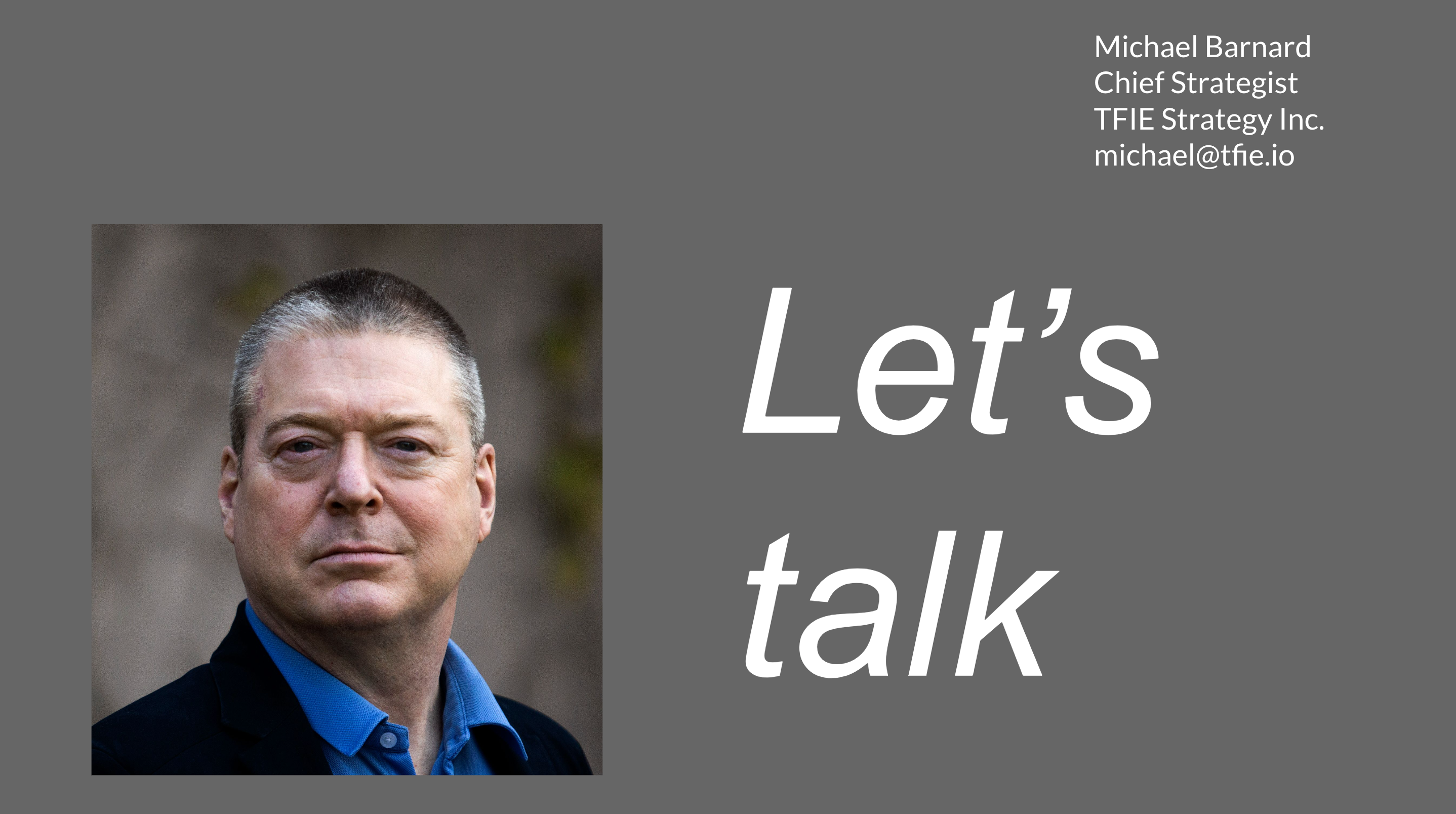
That’s it. Reji, over to you.
Reji Kumar Pillai: Thank you very much, Michael. I would now request Ravi to talk to the evolving SCADA with the physical dimensions and parameters. Over to you, Ravi.
Ravi: Yeah, I think it’s fascinating. I was hearing Michael the last time as well, and I think it’s teams and thoughts like this that must need to come out to drive policymakers as to where generally sensible work needs to be done. His last slide captures it. In fact, with respect to the top four, he talks of the Heimdall experiment of the Neurons. So in some way, Reji, I mean, thanks to you as you have allowed us to portray thermal inputs as a necessary and sufficient condition for both transmission and distribution. In some ways, four k eighty one is also calling for this, where they’re asking for a real-time four-hour forecast of temperature and therefore transmission capability, which would also force some kind of a temperature reading.
If you were to broadly sort the requirement into two or three buckets, the first bucket is the ambient temperature rise. What do we do with existing assets? The theory behind it is, you could just do a rule of thumb and depreciate or derate everything by 15%, but that would be trillions of dollars of balance sheet that gets wiped off utilities. It would make them unviable, literally just in one day. The key question is, how do you manage it? In the last three sessions that our ISUW and distribution utility meet, we’ve been discussing that we need to manage it. We’ve got all these access that we built to yesterday’s standards, and we need to manage it.
Knowing thermal limits, whether it’s a large transformer, large transmission line, or a distribution line, becomes key to knowing when I have pushed it to the limit and when I should not be pushing it to the limit based on what has occurred 4 hours before, based on loading. So that’s one.
The second is going forward is as you get more and more renewables, you get volatility in transmission and distribution because of the generation that comes up from time to time. We see that in western India, where 7000 swing currently takes place at least every other month or every three or four times a year. The question is, it has got great transmission, in fact the best in the world, in my view, every other country doesn’t match India’s interconnectivity, high voltage transmission, but yet it still requires some of these mitigation techniques to say, okay, when can I boost my transmission line capacity?
When would I say it is already fully loaded, I should do something else with it, start another generator or whatever. That volatility is there. In fact, because of renewable energy, at 30, 40, 50% of the total, the volatility continues to rise. That is a second issue.
The third issue is the standards around the world. I sit on some of the IEC standards, including how do we climate proof some of our electrical infrastructure? And it is slow. I’ll tell you, it is so slow that if even 10% of Michael’s ideas gets implemented, the standards would not change. And you know that, right?
In India, we’ve been asking for BIS to come in and actually take some leading role in these thoughts, and there is no thought. So the IEC is struggling with it, the Canadian standards, I said on some of the CSA committees is struggling with this as to how to define some of these concepts. By that time, I’ll tell you, the grid, a good chunk of the grid would be built for the next 10-15 years. So we are behind the eight ball in defining standards.
The question, I think, is that if we are able to get these physical inputs of ambient conditions and things like that, then we will be able to much better manage our assets, whether it was yesterday’s assets going forward, renewable energy that can be actually added on far more with confidence, and we’ll be able to manage it in real time much better. I think technology is here. I mean, Heimdall is one of the big ones right now, but we have other fiber optic technologies, right? I advise it. Another one that is fiber optic, temperature distributed temperature using fiber optic. So there are several mechanisms that are available today at a very low cost that we can actually implement, particularly transmission lines.
I think the time has come to take notice that we need to manage these assets and we need to push these assets, as opposed to just saying, let’s curtail them. Let’s curtail them. So I’ll stop here, Reji, and then I won’t steal Michael’s thunder here.
Reji Kumar Pillai: I could find only one question so far. So he’s talking about the difference between DLR dynamic line rating and the smart balls.
Michael Barnard: I would classify, and I urge Ravi to join in as necessary, dynamic line rating and smart balls as part of the continuum of dynamic line rating. Basically it says, what is the ambient temperature? What are the operating conditions we’ve been putting through the line up till now? What is the actual capacity? What is the sag ratio that is there based on the temperature?
There is a lot of DLR equipment, dynamic line rating technologies, to be applied. The advantage of the smart ball is that it’s dirt cheap and easy to install. I think it’s about US$32,000 per sensor. But it can be done with a drone. So a linesperson drives her truck out and she pops out of her truck. She pulls the ball out, she pulls the drone out, she sets it up, she makes sure the battery is charged. She controls the drone. It flies up, it drops the ball on the line. The ball automatically connects and locks in place, and she flies the drone down. Does a test to make sure that it’s worked, and she drives away. At that point, a mesh network starts communicating back to the control centers.
It’s easy to incrementally apply the magic ball technology with very simple modern technology at very low cost, across the highest risk to lowest risk lines, where you have the greatest concerns over possible benefits. I like it.
If we start talking about putting additional conductor, putting additional lines, fiber optics, across parallel to every single line or cross transmission lines, that’s a bigger ask than just dropping a ball on a line. Does that mean Heimdall is the best solution all the time? No, not at all. There’s a bunch of technologies in here. Everybody realizes, as Ravi was saying, we can manage our existing transmission and high voltage distribution quite easily, and we need to do that because that’s going to give us, enable us to avoid curtailment.
As Reji said, India is doing a great job at avoiding curtailment. China has done a great job at avoiding curtailment because they said, oh, well, we need actual transmission if we’re going to put renewables on. But the growth of renewables is so fast. It’s so easy to put in a wind farm. We can put an offshore wind farm with a gigawatt of capacity in ten months of construction. That’s offshore construction.
That’s amazing. It just blows the mind compared to the construction timelines of other generation assets, that speed and the cheapness of those generation assets is driving a supply curve line. Geographies like India and China are accelerating electrification with, for example, the 50,000 electric buses that India plans to have on its roads by 2027. That is truly driving those types of things. So we need to really be able to manage that.
Do you want to move on to the second question, Raji?
Reji Kumar Pillai: This talks about, can DLR be as effective in high temperature, low wind area compared to cold and windy areas?
Michael Barnard: I once again encourage Ravi to chime in, but I would say it’s more effective in high temperature areas because one of the things, it’s the capacity of the line is truly based upon the heat of the line and the sag and the engineering. You have to maintain the distance between the line and the ground. You also have to make sure that it doesn’t sag so much that it actually just separates. It gets weaker as it sags. That’s what sagging is. In high temperature areas, places where the ambient temperature is high or there’s fires or something, throttling that capacity with knowing the exact conditions enables existing lines to last longer to avoid outages in cold areas. While cold areas, you know, you can still get more capacity through, but your ambient temperature is much more generous to the line.
You’re not getting heat from the exterior like in Norway, where heat gets sucked off into the air quite nicely, while around New Delhi, well, maybe not so much..
The wind, that’s an interesting one, but not one I’d spent time thinking about yet. Ravi might have a perspective on that.
Ravi: The question is great. It helps more in the high temperature, in my view, because transmission lines are considered thermally low inertia. Therefore, even a little bit of wind actually can provide a much better effect on its transmission capability than in the colder areas because you already have the ambient working with you. It is even more important for countries like India now with the CEA thermal map. Reji can elaborate later, we need to now build on that to say, okay, how do we get even a little bit of wind that we can recognize allows for the 10%, 5% capability across. The second question, I think, is respect to across multiple geographies. When you have long transmission lines, you have multiple sensors with multiple temperatures and multiple winds.
Therefore, then the question becomes, how do I manage the tap stations? Some tap stations, I can probably operate more aggressively. The other ones where I have zero wind or very high temperature with zero wind, I may want to mitigate that in a different way. Whether it’s powerful power flow controllers, whatever, that might come later. By knowing my asset condition, from tap station to tap station, I just will be able to manage it better. The heat, the high heat with low wind, actually can reveal much better headroom than cold and heavy winds.
I just want to comment on something Michael said about large projects, especially the last slide. I think people should take away the last slide. There’s probably much more conversations to be had from policymakers. We, and I don’t wish toot our horn here, Larsen and Toubro’s power transmission division, on whose board I sit, we install right now gigawatt-scale solar in the Middle East. We have done Ras one, Ras two, all 18 months, 18 to 24 months, end to end. So that scale that we have, if you were to ever go and visit those stations, and, Reji, maybe you may want to.
I’ve done that twice, and it is amazing that the entire supply chain, the cost methodology of construction, the digitalization of construction, everything allows everything to be streamlined and installed. Two-kilometer rows of solar panels, it moves from what I call the old solar installation method into a bang, bang, literally a much more streamlined way of doing things which allows for lower and lower timelines. So I agree that it is very fast creation of supply. Based on that, Middle East, we have another one in the UAE, they’re going to do another one somewhere else. So it is now probably going to be normal in 600-megawatt stations that India did in solar will now be more like 1-1.2-gigawatt solar plants, which will just become the new normal. I think that’s perhaps the way to go as well, because the cost of power, the per kilowatt hour that comes from these stations, are even much cheaper than what we can get from smaller stations.
Reji Kumar Pillai: Already the solar wind generation globally is at 3 cents per kWh. It’s set to become 1 cent by end of this decade. That will be the cheapest form of energy in human history. It’s going to change everything. And storage cost is also falling down fast.
Ravi: That enables hydrogen as well. Right now the Saudi strategy is basically to take the large solar power and then attempt at desalination, attempt at hydrogen, just because the cost of power is so low. But not to transmit hydrogen. I fully agree with Michael. You don’t want to move hydrogen anywhere. I’ve written articles on that for you, Reji, and you would know the key aspect of it is how do I consume it where I am? And so now it enables it. Low cost renewable energy on a marginal basis is far cheaper than fossil plants. Today’s large-scale solar, large-scale wind, is allowing us to go and beat that new low with even newer and newer lows on a PPA basis, and which is where aqua and others have actually gone and capitalized for their capital financing for large-scale solar.
Michael Barnard: On that note, Reji is insisting that I’m going to do a single one of these discussions solely on my outlook on hydrogen and pull through some of the threads there. There is a lot of disinformation and hype and hope around hydrogen which needs to be disambiguated. I’ve spent a fair amount of time on that as well. Do look for that and schedule.
Reji Kumar Pillai: We will have that in one of this series, one of the presentations. So with that, we are come to the end of 1 hour. So thank you very much for all the participants.
Have a tip for CleanTechnica? Want to advertise? Want to suggest a guest for our CleanTech Talk podcast? Contact us here.
Latest CleanTechnica.TV Video
CleanTechnica uses affiliate links. See our policy here.



